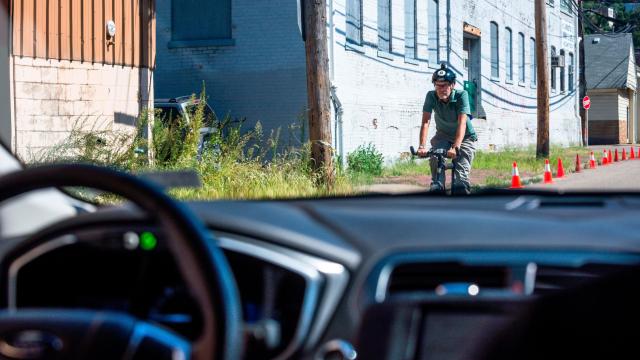New technology developed by researchers in Australia could help self-driving vehicles steer clear of pedestrians and cyclists without a direct line of sight, according to researchers from University researchers.
The team from the University of Sydney’s Australian Centre for Field Robotics reported they were able to make significant improvements in detection capability by linking vehicles to networks of roadside sensors and each other, resulting in what they termed “cooperative or collective perception (CP).” The “intelligent roadside units” (IRSUs) are equipped with gear like lidar sensors or cameras, which can then share the information with passing vehicles which in turn share it with others linked to the same network. The researchers compared the overall effect to an x-ray, allowing for the cars to be aware of objects falling outside direct visibility (such as a pedestrian behind a building, or a cyclist hidden by another vehicle).
While engineering difficulties have been the main barrier to autonomous car development, resolving safety concerns would also be necessary for them to receive regulatory approval or reassure a public that remains antsy about handing over the wheel to machines. Some previous studies on hidden hazard detection relied on technology like laser sensors and x-rays, or in the case of a 2019 MIT report, real-time lighting and shadow analysis that could detect an approaching pedestrian or vehicle. The approach detailed in the Australian research lends more data supporting an alternate approach, combining communication between cars with smart roads to provide each vehicle with multiple viewpoints.
According to the team’s report, vehicle-to-X (V2X) communication of environmental awareness data can be a “game changer for both human operated and autonomous vehicles” — not just because the growing use and standardization of such systems links equipped vehicles, but allows them to share warnings of other objects on the road that aren’t. They also detailed how such a collective perception system could be designed to allow for connected vehicles to account for uncertainties, such as sensors that aren’t 100% accurate or subject to environmental noise and interference, or how accurately a car tracks its own position on the road. The report also details other innovations, such as methods for distinguishing and tracking specific pedestrians.
Professor Eduardo Nebot of the Australian Centre for Field Robotics said in a press release that the researchers believe this technology could “substantially improve the efficiency and safety of road transportation.”
The researchers conducted several tests to demonstrate the potential of such a system to detect road hazards and prevent accidents. In one test involving a human-piloted car in an urban environment in Chippendale, Sydney, use of an IRSU allowed the vehicle to anticipate traffic activity “far beyond the reach of its onboard perception sensors” as well as “see” a “visually occluded pedestrian behind a building” seconds before it would have otherwise. Another test in a lab environment used an IRSU to feed a car simulated data on a jogger heading towards an intersection, where the car correctly braked and gave “way based on the predicted future state of the pedestrian” before they had ever entered the road. Other tests involving several vehicles linked via an IRSU, as well as ones conducted in the open-source CARLA simulator, had similarly satisfactory results and allowed the vehicles to anticipate obstacles like pedestrians and other normal cars on the road.
“Our research has demonstrated that a connected vehicle can ‘see’ a pedestrian around corners,” Mao Shan, the lead project researcher, said in the release. “More importantly, we demonstrate how connected autonomous vehicles can autonomously and safely interact with walking and running pedestrians, relying only on information from the ITS roadside station.”
The main obstacle for the system detailed in the report is that it would require infrastructure investments to build networks of roadside sensors that would help feed cars situational awareness data. But the research team argued that it could help lower the cost of autonomous driving and hazard detection in human-driven vehicles by sharing some of the required equipment, as well as mesh well with existing roads.
“[Collective perception] enables the smart vehicles to break the physical and practical limitations of onboard perception sensors, and in the meantime, to embrace improved perception quality and robustness along with other expected benefits from the CP service and V2X communication,” the researchers concluded in the report. “As importantly, the CP can also reduce the reliance on the vehicle’s local perception information, thereby lowering the requirement and cost for onboard sensing systems.”
“Furthermore, it is demonstrated that when properly used, perception data from other [intelligent transportation systems] can be used as another reliable source of information to add additional robustness and integrity to autonomous operations,” they added.
According to the report, the research team plans on continuing to develop the system, including developing “more advanced and ready-to-deploy” platforms, building an open standard for collective perception-enabled vehicles, and testing more advanced collective perception systems in both human and autonomously piloted vehicles in more complicated traffic environments.
Editor’s Note: Release dates within this article are based in the U.S., but will be updated with local Australian dates as soon as we know more.
